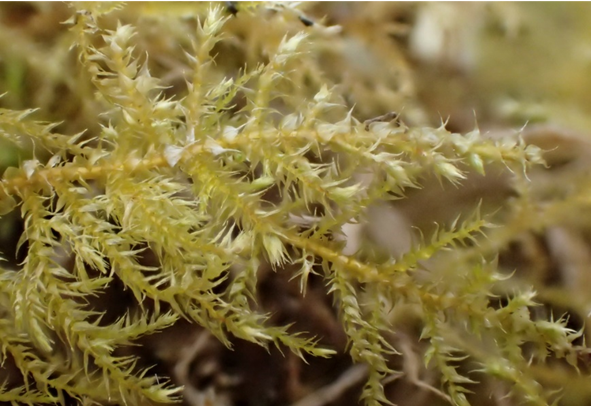
Mosses
Mosses are small non-vascular flowerless plants which together with liverworts and hornworts are known as bryophytes. There are around 1100 species of bryophyte in Britain and Ireland. Of these about 760 species are a moss.
Not surprisingly the greatest diversity in Britain’s moss flora is along our Atlantic coasts where our climate is wettest. Cambridgeshire by comparison is a dry place and, according to “Cambridgeshire Mosses and Liverworts”, 246 species were found in Cambridgeshire between 2000 and 2016.
The distinguishing features of mosses, liverworts and hornworts are described here .
Preliminary surveys at Abbey Fields have identified some of the mosses described below.
Croft Close Nature Reserve
The greatest variety of moss on Croft Close Nature Reserve is on the compressed sandy soil and anthills of the North- and South-rabbit-grazed lawns. Here around 30% of the ground cover is moss, with individual species giving different hues.
The bright green moss in the picture is Hornschuch's beard-moss (see gallery below) whereas the dull green is Bi-coloured bryum.
The yellowish green moss, most prolific at the edges of the walks is Rough-stalked feathermoss. An occasional island of plum red is appropriately called Redshank.
These well grazed and well-trodden mosses have little chance to put up spore cases to produce the next generation, but many mosses also reproduce vegetatively.
For example, in Bi-coloured bryum most rosettes hold globular growths between the leaves that are tubers ready to roll or be carried away. These will make new moss plants when they contact the soil allowing the moss carpet to still spread in well-trodden places.
In ‘belt and braces’ style Bi-coloured bryum does also produce spore capsules when it gets a chance by growing in a protected corner.
Bi-coloured Byrum
Bi-coloured Byrum Spores
Along the woodland paths one can’t fail to notice Common feathermoss on the ground and wrapped around the bases of young trees. With a hand lens the key feature of this moss is easily seen – the leaves of the central shoot are twice the size of the leaves on the side shoots.
Also, along one of the woodland paths Common smoothcap grows below bramble and hawthorn bushes. You might see one on the shady path passing from the Rabbit-grazed lawns towards the veteran oak and can easily recognise it from its undulating wavy and toothed leaf edges. This moss is scarce in Cambridgeshire, a new record for our area, with the nearest other records being Wicken Fen to the northeast and Gamlingay to the west (for detailed information see here. This is a large growing moss and unlike many of the others the others mentioned can easily be identified without a microscope.
Along the north boundaries of the Set-aside some of the young oaks have Wood bristle-moss growing on their trunks and branches, especially in the forks where most damp. This is an example of an ‘epiphyte’, or ‘air plant’.
A full list is with the other Set-aside flora here.
Long Meadow
With much of Long Meadow remaining as a hay meadow, the grasses and vascular plants dominate. To date, however, three species of moss have been recorded.
Two, Common feathermoss and Rough-stalked Feathermoss also occur at the Set-aside. The third, Pointed spear-moss, is found on the banks of the Brook.
Hornschuch's Beard-moss
Rough-stalked Feathermoss
Redshank
Common Feathermoss
Wood Bristle-Moss
Wood Bristle-Moss
Common Smoothcap






